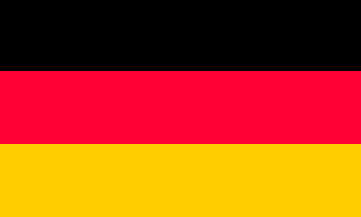
|
 |
part 1 |
Thursday 3 September 2020
Rotterdam - Boppard: 359 km (223 mi)
This year has been very diffeent for us too. We had planned to spend
three weeks on the Azores islands, but that had to be cancelled because
of the Corona crisis and the measures taken by the Azores authorities.
We adjusted our travel ambitions chose a destination closer to home,
which we could reach by car.
From Rotterdam we set out for Remage on 3 september, just south of Bonn.
The former railway station of 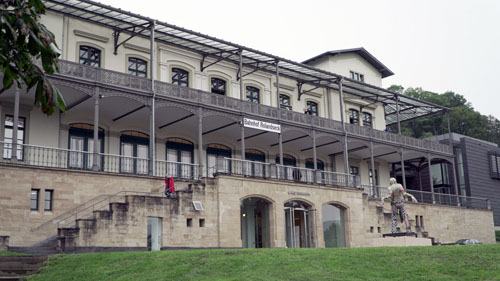 Rolandseck
has been transformed into a museum
showing the art collection of the French-German artist Hans
Arp (1886-1966). Apart from his own work there is a lot made
by Salvador Dalí, but also a number of temporary exhibitions. Behind the
station a new exhibition buidlding was built in 2007, designed by Richard
Meier, the architect known for The Barcelona Museum of
Contemporary Art, the Getty Center in LA, the Hague and San Jose City
Halls. Both parts of the museum are connected by an underground tunnel
underneath the railroad tracks.
Rolandseck
has been transformed into a museum
showing the art collection of the French-German artist Hans
Arp (1886-1966). Apart from his own work there is a lot made
by Salvador Dalí, but also a number of temporary exhibitions. Behind the
station a new exhibition buidlding was built in 2007, designed by Richard
Meier, the architect known for The Barcelona Museum of
Contemporary Art, the Getty Center in LA, the Hague and San Jose City
Halls. Both parts of the museum are connected by an underground tunnel
underneath the railroad tracks.
We have lunch in the restaurant Interieur
No. 253 which also based in the station building with a lovely
balcony with a view overlooking the rivere Rhine
After lunch and a visit of the museum we carry on to the town of Boppard
on the Rhine. The rain has stopped. We stay here at the Bellevue
hotel on the river bank.
Friday 4 September 2020
From Boppard we tour along the Rhine. We cross the river with one of
the numerous ferries - almost every town has one - drive up to the
famous 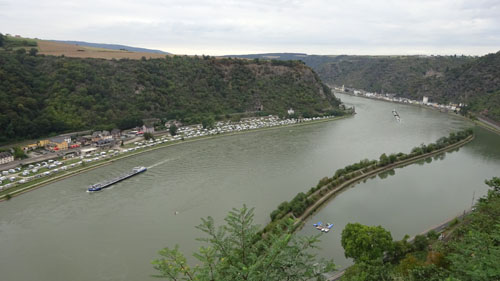 Loreley
op. The high cliff was where - according to legend - a nimph would
enchant the skippers, who subsequently would run aground and sink. The
reality is that this is the Rhine's narrowest passage with some sharp
bends, causing many ships to run aground. The sharpest edges have been
cut in the 1930s, but the passage still takes a lot of skill. From the
Loreley rock the view of the river is wonderful. When we arrive it very
quiet, but soon the place is taken over by bus loads of old age
pensioners, who are unfamiliar with the concept of social distancing.
Loreley
op. The high cliff was where - according to legend - a nimph would
enchant the skippers, who subsequently would run aground and sink. The
reality is that this is the Rhine's narrowest passage with some sharp
bends, causing many ships to run aground. The sharpest edges have been
cut in the 1930s, but the passage still takes a lot of skill. From the
Loreley rock the view of the river is wonderful. When we arrive it very
quiet, but soon the place is taken over by bus loads of old age
pensioners, who are unfamiliar with the concept of social distancing.
We drive down a gain and have a coffee in St Goarshausen before
we continue downstream to Kaub, home town to the Prussian Field
Marshall Bluecher. He battles side by side with the Duke of Wellington
against Napoleaon at Waterloo in 1814. We stroll along the narrow
streets of Kaub and cross the river again to Bacharach. That is
a lovely walled town with lots of half timbered houses and of course
vinyards on the steep slopes of the Rhine valley.  Meanwhile
the sun has come out and temperatures rise to a whopping 28 degrees
(82°F)
Meanwhile
the sun has come out and temperatures rise to a whopping 28 degrees
(82°F)
We loop back to Boppard and have a short break in our hotel. After that we take the Daarna gaan we met the chair lift up to Gedeonseck, where a splendid view on the river bend near Boppard is waiting for us. Ordering drinks at the Gedeonseck cafe is challenge, as the elderly ladies running it our overwhelmed by the number of customers. We take our chances at the Vierseeenblick. From this point you can see four stretches of the rivers as if they were four lakes. The cafe there is way better when it comes to service.
Back in Boppard we have a local wine at the Weinstube Heilig Grab and dinner somewhere in the centre of Boppard.
Weather: cloudy morning and 17 degrees (62°F). Sunny afternoon and 28
degrees (82°F)
Saturday 5 September 2020
Boppard - Bühlertal: 239 km (148 mi)
We drive to Speyer.
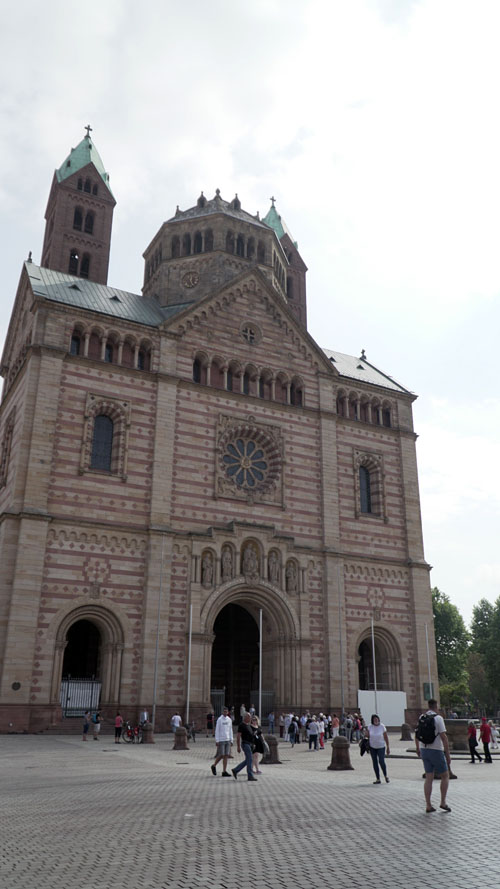 After
coffee and cake at great Konditorei on Maximilianstraße we walk to the
cathedral or dom. Above all the church is very tall. The tallest
and best preserved romanesque churches in the world. Since 1981 it has
been listed as UNESCO-world
heritage. In the course of centuries the church interior has been
looted and demolished, especially by the French. Nevertheless it is an
impressive cathedral. Construction started in 1030 under the rule of the
Salian king Conrad II and was not finished until the 19th century. The
Salian dynasty produced Roman-German kings and emperors and had it its
ancestral home in the Duchy of Franken. The were elected Roman King for
the first time in 1024 and subsequently annointed as Roman Emperor by the
pope. The imperial throne was lost in 1125 with the death of Heinrich V. I
go down the church crypt to have a look at the graves of these four
emperors. The crypt is seen as the largest underground collonade hall in
Europe. After this visit we walk down Maximilianstrasse until the city
gate. We double back along a quieter parallel street towards the Domhof
biergarten. That is where have lunch in the Beer Garden. It is getting
sunny and 26°C.
After
coffee and cake at great Konditorei on Maximilianstraße we walk to the
cathedral or dom. Above all the church is very tall. The tallest
and best preserved romanesque churches in the world. Since 1981 it has
been listed as UNESCO-world
heritage. In the course of centuries the church interior has been
looted and demolished, especially by the French. Nevertheless it is an
impressive cathedral. Construction started in 1030 under the rule of the
Salian king Conrad II and was not finished until the 19th century. The
Salian dynasty produced Roman-German kings and emperors and had it its
ancestral home in the Duchy of Franken. The were elected Roman King for
the first time in 1024 and subsequently annointed as Roman Emperor by the
pope. The imperial throne was lost in 1125 with the death of Heinrich V. I
go down the church crypt to have a look at the graves of these four
emperors. The crypt is seen as the largest underground collonade hall in
Europe. After this visit we walk down Maximilianstrasse until the city
gate. We double back along a quieter parallel street towards the Domhof
biergarten. That is where have lunch in the Beer Garden. It is getting
sunny and 26°C. Afte lunch we continue to Bühl, south of Baden-Baden. We shop for groceries at the local Kaufland Supermarket. All stocked up we drive to Bühlertal, where our Airbnb is. It is a spacious villa with a giant projection screen that serves a TV. We watch today's stage in the Tour de France. At night we have dinner at Bergfriedel, a fine restaurant with great views over the valley and the village. We sit outside on their roof terrace.
Weather: cool morning and overcast. Sunny afternoon and 28 degrees.
Sunday 6 September 2020
Bühlertal - Freudenstadt v.v.: 94 km (58 mi)
We have breakfast in our holiday home and after coffee set off early out of
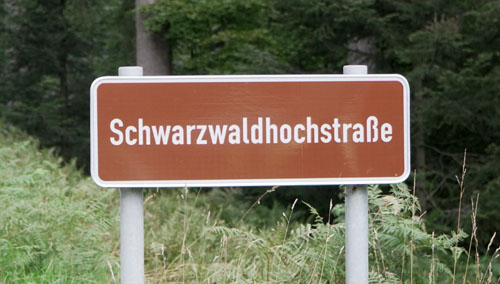 Bühlertal in an easterly direction along the Landesstraße 83 (state
route). We get out of the car and enjoy the view at Wiedenfelsen
and walk through the forest to Gertelbach falls . The view is
grand and the falls are nice. We have it all to ourselves this early in
the morning. We drive on to the Schwarzwaldhochstraße,
officially federal route B500. We head south.
Bühlertal in an easterly direction along the Landesstraße 83 (state
route). We get out of the car and enjoy the view at Wiedenfelsen
and walk through the forest to Gertelbach falls . The view is
grand and the falls are nice. We have it all to ourselves this early in
the morning. We drive on to the Schwarzwaldhochstraße,
officially federal route B500. We head south. After a while we get to Mummelsee. A small mountain lake with a hotel on its shore. It less than quiet here. It seems to be a popular day out on a Sunday. We have some expensive cofffees and do a tour around the lake on foot. We than charge on along the B500 until the turnoff to the local road Kreisstraße 5370 which takes us to the ruins of a monastery called Allerheiligen near Oppenau. It is a premonstratenzer monastery that was created in the 11th century and was disbanded in 1802 by Friedrich von Baden. It was finally deserted in 1830
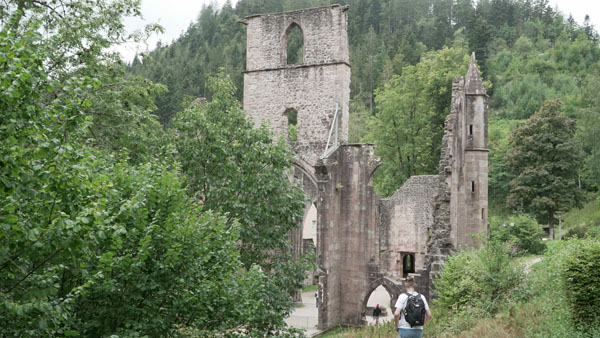 . The buildings fell into disrepair. From the ruins a walking track leads
us through the Lierbach valley to a waterfall. By now most people seem to
have woken up and taken to the countryside. The walk is nice enough and so
are the falls. We are a bit surprised by the crowds though.
. The buildings fell into disrepair. From the ruins a walking track leads
us through the Lierbach valley to a waterfall. By now most people seem to
have woken up and taken to the countryside. The walk is nice enough and so
are the falls. We are a bit surprised by the crowds though.We carry on to Freudenstadt, a fairly unremarkable town where we have a pizza. We want to loop back to Buhlertal via the B462, but that one is blocked somewhere and we are rerouted towards the same old B500. We pass the Mummelsee and a few other attraction points which are heaving with day trippers by now. The parking lot is spilling on to roadside for miles.
Weather: dry. Cool morning 13 degrees, max 17 graden in the afternoon (depending on the altitude)
Monday 7 September 2020
Bühlertal - Baden-Baden: 24 km (15 mi)
After breakfast we drive up to Baden Baden via de A5 motorway. We park on the P&R parking house near the Cineplex cinema. From there we take
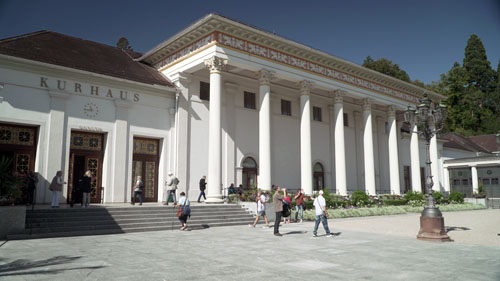 bus
205 into town. Our parking fee includes a ride on the bus into the city
centre (max. 5 persons and only line 205). The bus brings us to
Leopoldplatz. From there we walk to the Trinkhalle (drinking Hall).
This was built in 1839 as an addition to the Kurhaus. The gallery is
adorned with frescoes depicting German myths and legends. Inside you can
get a cup of local spring water. There is also a branch of the local
tourist office. From the Trinkhalle we walk through the park to the Stourdza
church. This church was commisioned by the last king of Moldaviaë to
commemorate his son Michael, who died at the age of 17. The church is
built in Romanian-Orthodox sytle, but is unfortunately under renovation
and closed to visitors. We walk towards the Casion and Kurhaus.
In the casino we go on a (German) guided tour. It starts at 11am. Before
we join our temperature is measured. On the tour it proves to be difficult
to keep a safe distance from the other participants. Above all the casino
creation by Jacques Benazet, who controled the casino from 1838.
Baden-Baden grew to become a cosmopolitan centre for gambling, baths and
networking for the elite of the day and captured royalty from Britain,
Russia and France.
bus
205 into town. Our parking fee includes a ride on the bus into the city
centre (max. 5 persons and only line 205). The bus brings us to
Leopoldplatz. From there we walk to the Trinkhalle (drinking Hall).
This was built in 1839 as an addition to the Kurhaus. The gallery is
adorned with frescoes depicting German myths and legends. Inside you can
get a cup of local spring water. There is also a branch of the local
tourist office. From the Trinkhalle we walk through the park to the Stourdza
church. This church was commisioned by the last king of Moldaviaë to
commemorate his son Michael, who died at the age of 17. The church is
built in Romanian-Orthodox sytle, but is unfortunately under renovation
and closed to visitors. We walk towards the Casion and Kurhaus.
In the casino we go on a (German) guided tour. It starts at 11am. Before
we join our temperature is measured. On the tour it proves to be difficult
to keep a safe distance from the other participants. Above all the casino
creation by Jacques Benazet, who controled the casino from 1838.
Baden-Baden grew to become a cosmopolitan centre for gambling, baths and
networking for the elite of the day and captured royalty from Britain,
Russia and France. 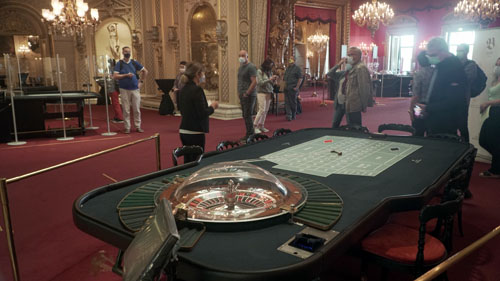 Baden-Baden got a horse racing course, a theatre and a philharmonic where
the starts of the day performed, among which Johannes Brahms. We are shown
the gaming tables for roulette and blackjack and also the bars. It all
looks splendid.
Baden-Baden got a horse racing course, a theatre and a philharmonic where
the starts of the day performed, among which Johannes Brahms. We are shown
the gaming tables for roulette and blackjack and also the bars. It all
looks splendid. We walk into the old town centre, the Altstadt for lunch. After lunch at Le Bistro we continue to the Friedrichsbad, the oldest bath house in town named after Grand Duke Friedrich I of Baden. Friedrich wanted to revive the spa, because gambling was about to be declared illegal by the Prussian king (and future German emperor) Wilhelm I. With the new spa Baden-Baden could prevent its economy from falling into decline. The Friedrichsbad – now closed because of Corona – has a spa circle of no less than 17 stages. Next to it are the modern Caracalla thermen, which are open. We walk through town towards the theatre from 1862. From here the Lichtetaler Allee runs south. The green zone along the River Oos leads to the former village of Lichtental. A bit further down is the Kunsthalle (Art Hall) and next to it the
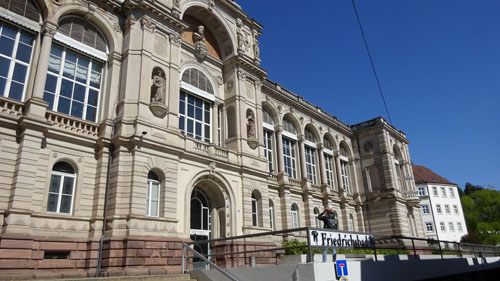 Burda collection, housed in a building designed by Richard
Meier. The Burda family became rich with its fashion magazine with
the same name. We continue towards the Gönner Anlag, a formal rose
garden named after a former mayor. We have a drink in a tea garden next to
a tennis club. From there it is only a few steps to the Dahlia garden,
where 64 species of this flower blossom. Along the banks of the river Oos
we see one luxurious hotel after the next one. Beautiful buidlings set in
magnificent gardens. At the end of the park we get to the monastery
of Lichtental, which is still run by 30 cistercenser nuns, as a Gast
House among other things. We get on a Next
Bike bicycle and ride to the Brahms house. The composer lived here
during the summers of 1865 through 1874. He came to keep company with the
widow of his collegue Schumann, but also composed various pieces and gave
concerts with the Casino philharmonic. The NextBike bicycles can be
unlocked and rented by means of an app on your smartphone. NextBike is
also active back home in the Netherlands and the Dutch app works here too
and not only in Baden-Baden.
Burda collection, housed in a building designed by Richard
Meier. The Burda family became rich with its fashion magazine with
the same name. We continue towards the Gönner Anlag, a formal rose
garden named after a former mayor. We have a drink in a tea garden next to
a tennis club. From there it is only a few steps to the Dahlia garden,
where 64 species of this flower blossom. Along the banks of the river Oos
we see one luxurious hotel after the next one. Beautiful buidlings set in
magnificent gardens. At the end of the park we get to the monastery
of Lichtental, which is still run by 30 cistercenser nuns, as a Gast
House among other things. We get on a Next
Bike bicycle and ride to the Brahms house. The composer lived here
during the summers of 1865 through 1874. He came to keep company with the
widow of his collegue Schumann, but also composed various pieces and gave
concerts with the Casino philharmonic. The NextBike bicycles can be
unlocked and rented by means of an app on your smartphone. NextBike is
also active back home in the Netherlands and the Dutch app works here too
and not only in Baden-Baden. We cycle back to the town centre and return the bike to a rental hub before we take the bus back to the P&R. From there we drive back to Bühl and do some shopping for groceries at Kaufland.
We eat at our Airbnb en watch the football match Netherlands vs Italy for the Uefa Nations League. Unfortunately the Netherlands lose with 0-1.
Weather: cool start, but sunny and warm later on. Up to 24 degrees.
Tuesday 8 September 2020
We are not going to Strasbourg acroos the border in France, which we planned to do. Strasbourg and the district of Bas-Rhin got the designation Red Zone last Sunday, because the number of new daily Corona infections exceeded 50 in every afgelopen zondag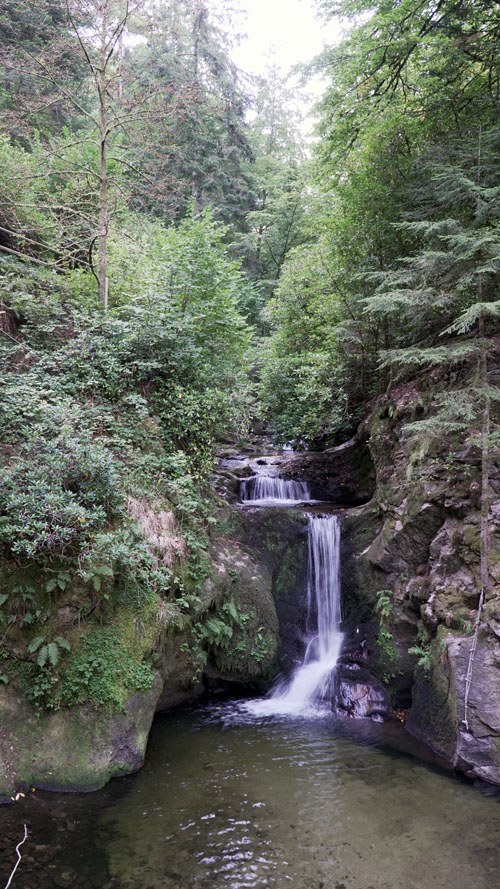 van
de Franse regering benaming Zone Rouge, omdat het aantal Corona- 100.000
inhabitants. This is why face masks have become obligatory in public
spaces both indoors and outdoors. The Netherlands nor Germany have imposed
any restrictions for travel to and from this part of France, but we prefer
to err on the side of caution. This is why we drive to nearby Geroldsau,
to have a look at the waterfalls there. It is about 1.5 km walk from the
Federal Bundestrasse 500 through the woods and along a stream. Nice area.
When we get there it is very quiet. On the way back to the car is gets
busier. We carry on to Geroldsau itself for coffee and cake at the Geroldsauermühle,
een bakery, shop, restaurant and hotel in one. From there we continue to
the Hohe Felsburg ruins just outside Baden-Baden. The former castle is
high a above the city and was home to the Margraves of Baden. The views
are disappointing, because we cannot climbt up the tower and wall, which
are closed for restauration works. The restaurant is closed on account of
a Ruhetag (resting day).
van
de Franse regering benaming Zone Rouge, omdat het aantal Corona- 100.000
inhabitants. This is why face masks have become obligatory in public
spaces both indoors and outdoors. The Netherlands nor Germany have imposed
any restrictions for travel to and from this part of France, but we prefer
to err on the side of caution. This is why we drive to nearby Geroldsau,
to have a look at the waterfalls there. It is about 1.5 km walk from the
Federal Bundestrasse 500 through the woods and along a stream. Nice area.
When we get there it is very quiet. On the way back to the car is gets
busier. We carry on to Geroldsau itself for coffee and cake at the Geroldsauermühle,
een bakery, shop, restaurant and hotel in one. From there we continue to
the Hohe Felsburg ruins just outside Baden-Baden. The former castle is
high a above the city and was home to the Margraves of Baden. The views
are disappointing, because we cannot climbt up the tower and wall, which
are closed for restauration works. The restaurant is closed on account of
a Ruhetag (resting day).We go on to Bad Wildbad. Also a spa resort in the Black Forest, but a lot smaller and more down to earth than Baden-Baden. It is not that easy to get there. It is not on a federal main route and quite a few of the roads to it are blocked for road works.
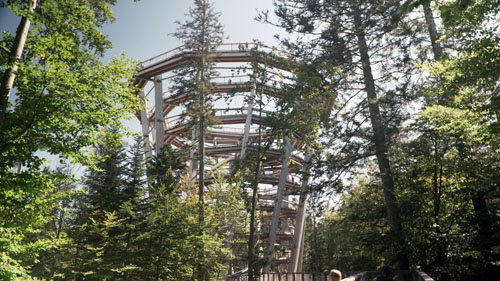 get
there by 1.15pm. We have lunch and order some Badish specialties
(Maultaschen) and head for the funicular,
up the Sommerberg . Once up there we get on to the elevated
walkway connecting the tree tops, the
Baumwipfelpfad (or tree top path). This leads us to a look out tower
with a spiral walk way leading us up to the top. We are rewarded with
great views of the area. It is kind of crowded. At the foot of the tower
is a children's playground. The schools have not started yet in this part
of Germany, so that explains the crowds.
get
there by 1.15pm. We have lunch and order some Badish specialties
(Maultaschen) and head for the funicular,
up the Sommerberg . Once up there we get on to the elevated
walkway connecting the tree tops, the
Baumwipfelpfad (or tree top path). This leads us to a look out tower
with a spiral walk way leading us up to the top. We are rewarded with
great views of the area. It is kind of crowded. At the foot of the tower
is a children's playground. The schools have not started yet in this part
of Germany, so that explains the crowds. We drive back to Bühlertal. At night we have dinner at Rebstock. Fine food, we feel rushed through the meal.
Weather: sunny, 24 degrees max.
Wednesday 9 September 2020
Today's theme is wineries of the Northern part of the Baden region. We follow the Badische Weinstrasse route. Not as easy as it sounds, as the route is not signposted. All we have is pdf-map on my phone. We start in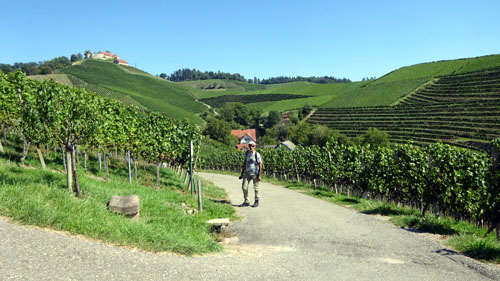 Bühlertal
where we leave the L87 south bound. First we drive through a boring part
with few grapes and mostly apple trees, but after a while we see more
slopes with endless lines of vines. We drink coffee in Kappelrodeck and
move on to Waldulm and arrive at Durbach after a few hours. That
village is the epicentre of the Openau wine district. We get out of the
car for a walk. Because we are not entirely sure where the walk starts I
ask at the local tourist office for directions. They are extremely helpful
in explaining the course of the walk, where we have to start and how the
signing system works. A real help. Before set out, we grab some food at a
bakery and then drive to the parking lot in front of the swimming pool,
where the walk starts.
Bühlertal
where we leave the L87 south bound. First we drive through a boring part
with few grapes and mostly apple trees, but after a while we see more
slopes with endless lines of vines. We drink coffee in Kappelrodeck and
move on to Waldulm and arrive at Durbach after a few hours. That
village is the epicentre of the Openau wine district. We get out of the
car for a walk. Because we are not entirely sure where the walk starts I
ask at the local tourist office for directions. They are extremely helpful
in explaining the course of the walk, where we have to start and how the
signing system works. A real help. Before set out, we grab some food at a
bakery and then drive to the parking lot in front of the swimming pool,
where the walk starts. 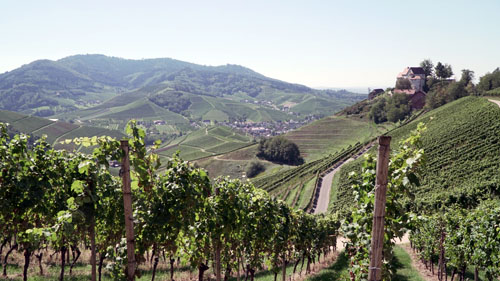 The
first part is the so called wine learning track. On this part of the route
the farmers have planted all the grape varieties they use here with signs
explaining the history and the characteristics of the grapes. Then it goes
steeply uphill towards the Staufenberg castle. This castle is the
home of a winery and a michelin star restaurant cum wine shop. We are so
out of breath that we give the shop a miss and go on downhill through the
fields back to Durbach.
The
first part is the so called wine learning track. On this part of the route
the farmers have planted all the grape varieties they use here with signs
explaining the history and the characteristics of the grapes. Then it goes
steeply uphill towards the Staufenberg castle. This castle is the
home of a winery and a michelin star restaurant cum wine shop. We are so
out of breath that we give the shop a miss and go on downhill through the
fields back to Durbach. From there we head back to our Airbnb.
Weather: clear sky and max 28 degrees (82°F).
Thursday 10 September 2020
Bühlertal - Freiburg im Breisgau: 104 km
We drive from Bühlertal via A5 motorway to Durbach where we were yesterday. Now we head straight for the Vinothek of the Durbacher Winzergenossenschaft, een Wine farming collective. Here, we can taste and select local wines. The samples are generous. We leave the place with a Weißburgunder (pinot blanc), a Riesling and a Spätburgunder (pinot noir). We arrive at our Airbnb in Freiburg im Breisgau around 1pm. We have lunch at Asian eatery down the street and go shopping at the nearby Edeka supermarket. We watch the Tour de France live coverage on TV. In the evening we eat in our Airbnb en go for a evening walk.
Weather: sunny, 28 degrees
 |
Other Travel |  |
| back | continue |